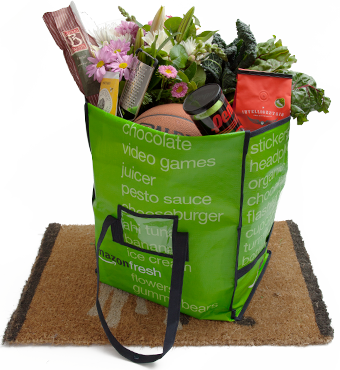Walmart using its superstores as cross docks for its smaller stores. Aivars Lode avantce
Wal-Mart predicts sales will grow faster next year
The world's largest retailer sees a "tough" and "unpredictable" economy around the world, Chief Executive Officer Mike Duke said, a week after the International Monetary Fund trimmed its outlook for global growth.
Wal-Mart expects its overall sales to rise to $475 billion to $480 billion this fiscal year, a gain of about 1.9 percent to 3 percent over last year's $466.11 billion. For fiscal 2015, which begins in February, it is targeting 3 percent to 5 percent growth, Chief Financial Officer Charles Holley said at the company's meeting with investors and analysts in Arkansas. The meeting was also webcast.
Positive economic signs such as a declining unemployment rate, along with Wal-Mart's efforts such as better merchandising plans, new stores and ecommerce plans, makes the company confident it can grow sales faster next year, Holley said.
Still, U.S. customers remain under pressures from higher income taxes, gas and food prices, plus the government shutdown, and they are trying to stick to budgets.
Wal-Mart is not waiting for the holiday season to get aggressive on pricing. Walmart U.S., its largest business by far, is promoting low prices on everything from Kraft's (KRFT.O) Velveeta cheese and PepsiCo Inc's (PEP.N) Doritos chips to Procter & Gamble Co's (PG.N) Pampers diapers and Bounty paper towels this month, while Sam's Club will have another discount booklet for members starting on October 30, as both chains try to boost sales early in the fourth quarter.
More than 1 million people have already signed up for holiday layaway, which allowsWalmart U.S. shoppers to put items on hold and pay for them over time. Four of the top five items on layaway are devices including Google Inc (GOOG.O) Nexus tablets, HP's (HPQ.N) HP 2000 laptop, the Hisense Sero 7 tablet and Fuhu Inc's nabi 2 Kids' tablets, Holley told reporters.
FURLOUGH IMPACT
Walmart U.S. feels pretty good about its profit but is not satisfied with its sales, Simon said.
Same-store sales at Walmart U.S. unexpectedly fell 0.3 percent in the 13-week period that ended in late July. Same-store sales at the bottom 10 percent of its large U.S. supercenters were down 7.5 percent in that period, he added.
Walmart U.S. said it is testing using its supercenter stores as "cross docks" to supply nearby smaller stores, a move that could help it keep goods in stock and cut costs. The system is set to roll out in the first of three unnamed markets in March.
Using the back room of a supercenter as a "little mini warehouse" for daily deliveries to smaller stores would eliminate the need to send 53-foot trucks from distribution centers to smaller stores, Walmart U.S. CEO Bill Simon said.
"I think it's a fundamental shift in their real estate strategy" to look at things market-by-market rather than store-by-store and is a "sophisticated development," said Stewart Samuel, program director at IGD, who attended Tuesday's meeting.
Those types of efforts, plus continued investment in ecommerce, should pay off over time, Samuel said. Wal-Mart, which is opening more ecommerce fulfillment centers and filling some orders from stores, expects $13 billion in ecommerce sales in fiscal 2015, up from $10 billion or more this year.
Thousands of federal workers have been furloughed in the impasse over the U.S. budget and Walmart U.S. CEO Bill Simon said that if people were not getting paid, they were not shopping as much. Sam's Club CEO Rosalind Brewer said that just over 40,000 people came to shop at its warehouse clubs after the chain waived its usual fee for those who could not access military commissaries closed in the shutdown.
Wal-Mart shares ended the day down 31 cents, or 0.42 percent, at $74.37. Through Monday, the shares were up 10 percent this year, underperforming the 19.7 percent gain in the S&P 500 .SPX.
SLOWING INTERNATIONAL GROWTH
Bentonville, Arkansas-based Wal-Mart is still committed to trying to grow operating expenses at a slower rate than sales. Overall, capital spending is set to be $12 billion to $13 billion this year and $11.8 billion to $12.8 billion next year.
The company is closing about 50 under-performing stores out of hundreds it has in the major emerging markets of Brazil and China, said Walmart International Chief Executive Doug McMillon. The company said the stores set to close represent about 2 percent to 3 percent of its sales in each of those markets, although it is still opening new stores as well.
For the first time, Walmart U.S. plans to open more smaller-format stores than supercenters. Walmart U.S. plans to open 235 to 265 stores in fiscal year 2015, about 120 to 150 of them small stores. It is planning for about 245 openings this year, slightly above an earlier forecast.
Wal-Mart now plans to open 34 million square feet of new store space this year, down from its original forecast of 36 million to 40 million square feet. For next year, it targeted 33 million to 37 million in new store space, with more than half of the space being added in Walmart U.S., which will open more smaller stores than larger ones. The pace of growth internationally may continue to slow.







